Influence of Tailored Surfaces and Superimposed-Oscillation on Sheet-Bulk Metal Forming Operations
Abstract
:1. Introduction
2. Materials and Methods
2.1. Materials
2.2. Forming Process
2.3. High-Feed Milling of Quasi-Deterministic Surface Structures
2.4. PVD-Coating Technology
2.5. Plane-Strain Compression Test with and without Oscillation Overlay
3. Results and Discussion
3.1. Plane-Strain Compression Tests
3.2. First Stage of the SBMF
4. Conclusions
Author Contributions
Funding
Conflicts of Interest
References
- Merklein, M.; Allwood, J.M.; Behrens, B.-A.; Brosius, A.; Hagenah, H.; Kuzman, K.; Mori, K.; Tekkaya, A.-E.; Weckenmann, A. Bulk forming of sheet metal. CIRP Ann. 2012, 61, 725–745. [Google Scholar] [CrossRef]
- Salfeld, V.; Krimm, R.; Hübner, S.; Vucetic, M. Sheet-Bulk Metal Forming of Symmetric and Assymetric Parts. Adv. Mater. Res. 2013, 769, 229–236. [Google Scholar] [CrossRef]
- Nevill, G.E.; Brotzen, E.; Franz, B. The effect of vibrations on the static yield strength of low carbon steel. ASTM Proc. 1957, 57, 751–758. [Google Scholar]
- Blaha, F.; Langenecker, B. Plastizitätsuntersuchungen von Metallkristallen im Ultraschallfeld. Acta Metall. 1959, 7, 93–100. [Google Scholar] [CrossRef]
- Izumi, O.; Oyama, K.; Suzuki, Y. Effects of superimposed ultrasonic vibration on compressive deformation of metals. Trans. Jpn. Inst. Met. 1966, 7, 162–167. [Google Scholar] [CrossRef] [Green Version]
- Bagherzadh, S.; Abinia, K. Effect of ultrasonic vibration on compression behavior and microstructural characteristics of comercially pure aluminium. J. Mater. Eng. Perform. 2015, 24, 4364–4376. [Google Scholar] [CrossRef]
- Bunget, C.; Ngaile, G. Influence of ultrasonic vibration on micro-extrusion. Ultrasonics 2011, 51, 606–616. [Google Scholar] [CrossRef] [Green Version]
- Kirchner, H.O.K.; Kromp, W.K.; Prinz, F.B.; Trimmel, P. Plastic deformation under simultaneous cyclic and unidirectional loading at low and ultrasonic frequencies. Mater. Sci. Eng. 1985, 68, 197–206. [Google Scholar] [CrossRef]
- Koch, S.; Vucetic, M.; Hübner, S.; Bouguecha, A.; Behrens, B.-A. Superimposed oscillating and non-oscillating ring compression tests for sheet-bulk metal forming technology. In Advanced Materials Research; Trans Tech Publications: Stafa-Zurich, Switzerland, 2015; Volume 794, pp. 89–96. [Google Scholar]
- Gröbel, D.; Schult, R.; Hildenbrand, P.; Lechner, M.; Engel, U.; Sieczkarek, P.; Wernicke, S.; Gies, S.; Tekkaya, A.E.; Behrens, B.A.; et al. Manufacturing of functional elements by sheet-bulk metal forming processes. Prod. Process. Ger. Acad. Soc. Prod. Eng. (WGP) 2016, 10, 63–80. [Google Scholar] [CrossRef]
- Behrens, B.-A.; Bouguecha, A.; Vucetic, M.; Hübner, S.; Rosenbusch, D.; Koch, S. Numerical and experimental investigations of multistage sheet-bulk metal forming process with compound press tools. Key Eng. Mater. 2015, 651, 1153–1158. [Google Scholar] [CrossRef]
- Vierzigmann, U.; Merklein, M.; Engel, U. Tailored Surfaces in Sheet-BulkMetal Forming, Tribology of Manufacturing Processes. In Proceedings of the 4th ICTMP International Conference on Tribology in Manufacturing Processes, Nice, France, 13–15 June 2010; Volume 2, pp. 541–550. [Google Scholar]
- Löffler, M.; Andreas, K.; Engel, U.; Schulte, R.; Gröbel, D.; Krebs, E.; Freiburg, D.; Biermann, D.; Stangier, D.; Tillmann, W.; et al. Tribological measures for controlling material flow in sheet-bulk metal forming. Prod. Eng. 2016, 10, 459–470. [Google Scholar] [CrossRef]
- Löffler, M.; Schulte, R.; Freiburg, D.; Biermann, D.; Stangier, D.; Tillmann, W.; Merklein, M. Control of the material flow in sheet-bulk metal forming using modifications of the tool surface. Int. J. Mater. Form. 2019, 12, 17–26. [Google Scholar] [CrossRef]
- Kersting, P.; Gröbel, D.; Merklein, M.; Sieczkarek, P.; Wernicke, S.; Tekkaya, A.E.; Krebs, E.; Freiburg, D.; Biermann, D.; Weikert, T.; et al. Experimental and numerical analysis of tribological effective surfaces for forming tools in Sheet-Bulk Metal Forming. Prod. Eng. 2016, 10, 37–50. [Google Scholar] [CrossRef]
- Tillmann, W.; Stangier, D.; Lopes-Dias, N.-F. Adjustment of friction by duplex-treated, bionic structures for Sheet-Bulk Metal Forming. Tribol. Int. 2017, 111, 9–17. [Google Scholar] [CrossRef]
- Sieczkarek, P.; Wernicke, S.; Gies, S. Wear behavior of tribologically optimized tool surfaces for incremental forming processes. Tribol. Int. 2016, 104, 64–72. [Google Scholar] [CrossRef]
- Podgornik, B.; Hogmark, S.; Sandberg, O. Proper coating selection for improved galling performance of forming tool steel. Wear 2006, 261, 15–21. [Google Scholar] [CrossRef]
- Freiburg, D. Hochvorschubfräsen zur Strukturierung von Werkzeugoberflächen für Die Blechmassivumformung; Vulkan Verlag: Essen, Germany, 2019. [Google Scholar]
- Abele, E.; Dewald, M.; Heimrich, F. Leistungsgrenzen von Hochvorschubstrategien im Werkzeug- und Formenbau. ZWF Z. Wirtsch. Fabr. 2010, 105, 737–743. [Google Scholar] [CrossRef]
- Hense, R.; Kersting, P.; Vierzigmann, U.; Löffler, M.; Biermann, D.; Merklein, M.; Wels, C. High-Feed Milling of Tailored Surfaces for Sheet-Bulk Metal Forming Tools. Prod. Eng. 2015, 9, 215–223. [Google Scholar] [CrossRef]
- Tillmann, W.; Stangier, D.; Hagen, L. Influence of the WC grain size on the properties of PVD/HVOF duplex coatings. Surf. Coat. Technol. 2017, 328, 326–334. [Google Scholar] [CrossRef]
- Tillmann, W.; Hagen, L.; Stangier, D. Influence of etching-pretreatment on nano-grained WC-Co surfaces and properties of PVD/HVOF duplex coatings. Surf. Coat. Technol. 2019, 374, 32–43. [Google Scholar] [CrossRef]
- Becker, N. Weiterentwicklung von Verfahren zur Aufnahme von Fließkurven im Bereich Hoher Umformgrade; Springer: Berlin, Germany, 1994. [Google Scholar]
- Lum, I.; Huang, H.; Chang, B.H.; Mayer, M.; Du, D.; Zhou, Y. Effects of superimposed ultrasound on deformation of gold. J. Appl. Phys. 2009, 105, 024905. [Google Scholar] [CrossRef]
- Huang, H.; Pequegant, A.; Chang, B.H.; Mayer, M.; Du, D.; Zhou, Y. Influence of superimposed ultrasound on deformation of Cu. J. Appl. Phys. 2009, 106, 113514. [Google Scholar] [CrossRef]
- Siu, K.W.; Ngan, A.H.W.; Jones, I.P. New insight on acoustoplasticity-ultrasonic irradiation enhances subgrain formation during deformation. Int. J. Plast. 2011, 27, 788–800. [Google Scholar] [CrossRef]
- Yao, Z.; Kim, G.-Y.; Faidly, L.; Zou, Q.; Mei, D.; Chen, Z. Experimental study of high-frequency vibration assisted micro/mesoscale forming of metallic materials. J. Manuf. Sci. Eng. 2011, 133, 061009. [Google Scholar] [CrossRef] [Green Version]
- Rozner, A.G. Effect of ultrasonic vibration on coefficient of friction during strip drawing. J. Acoust. Soc. Am. 1971, 49, 1368–1371. [Google Scholar] [CrossRef]
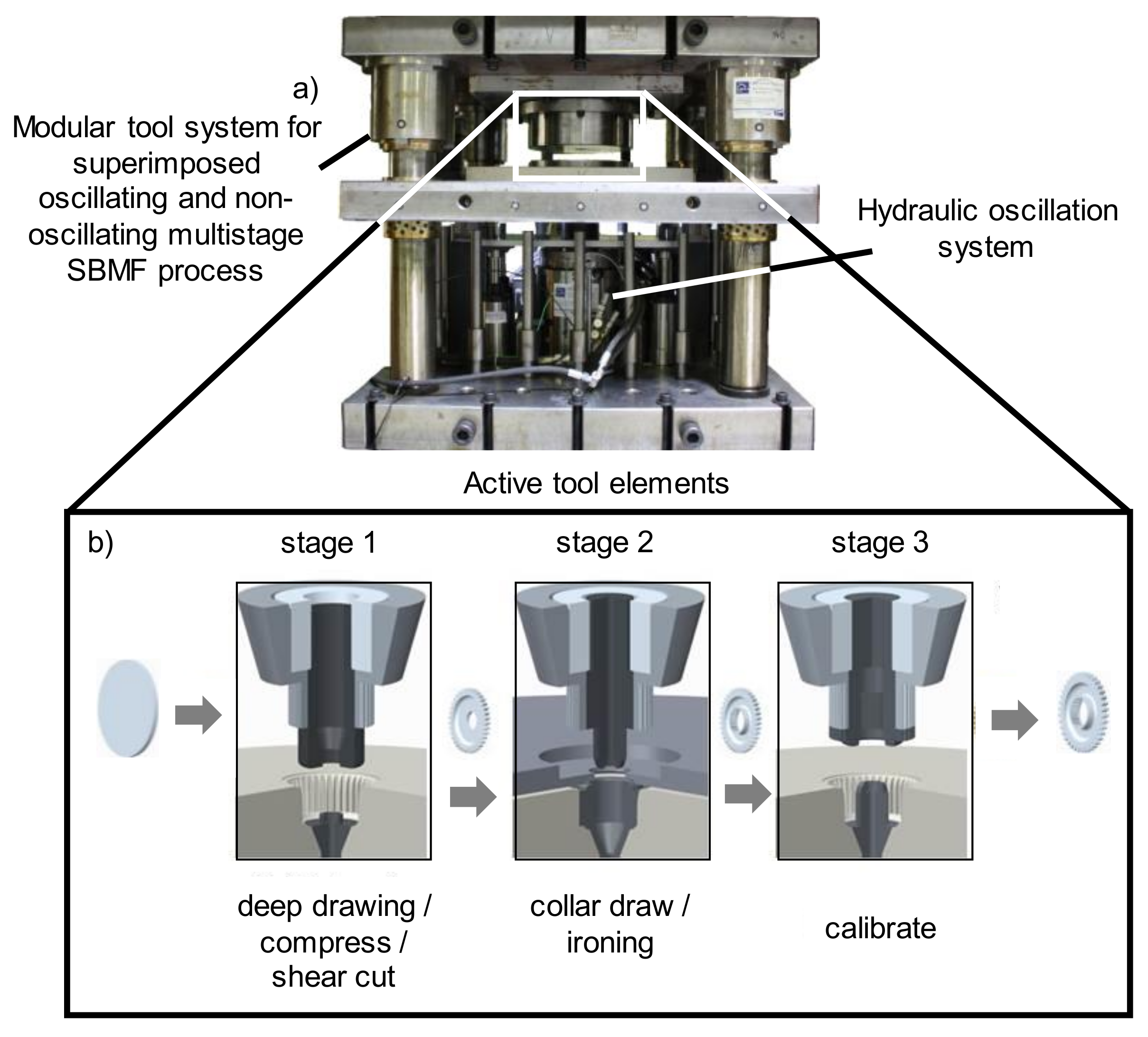
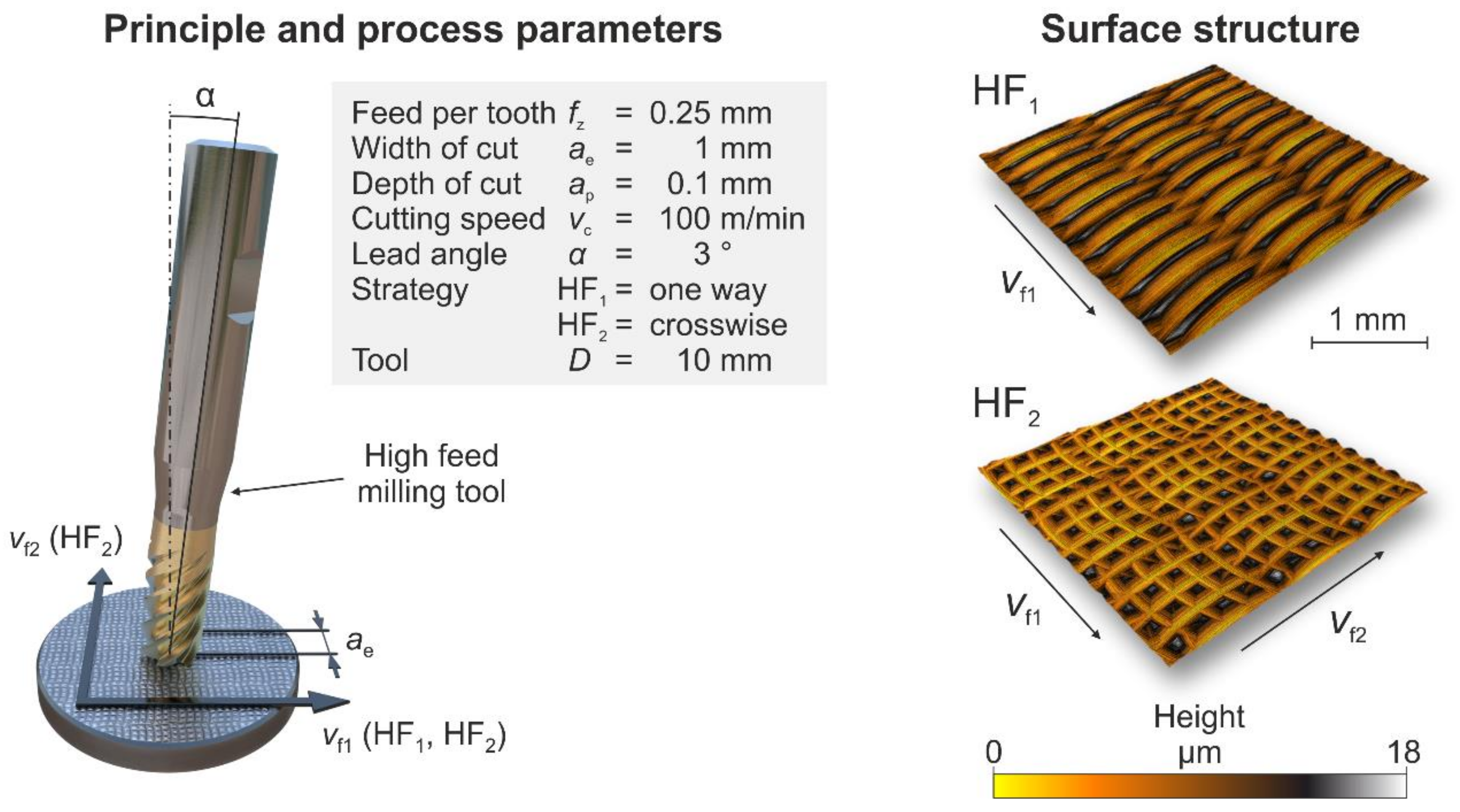
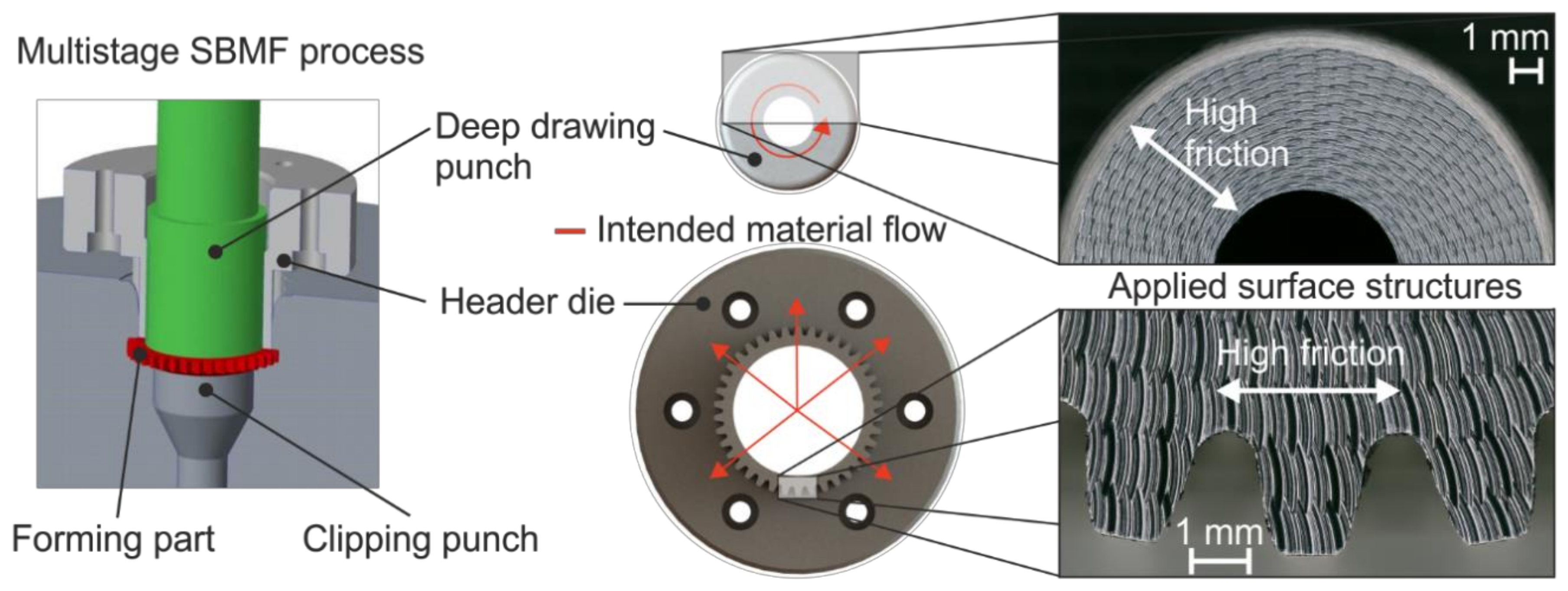
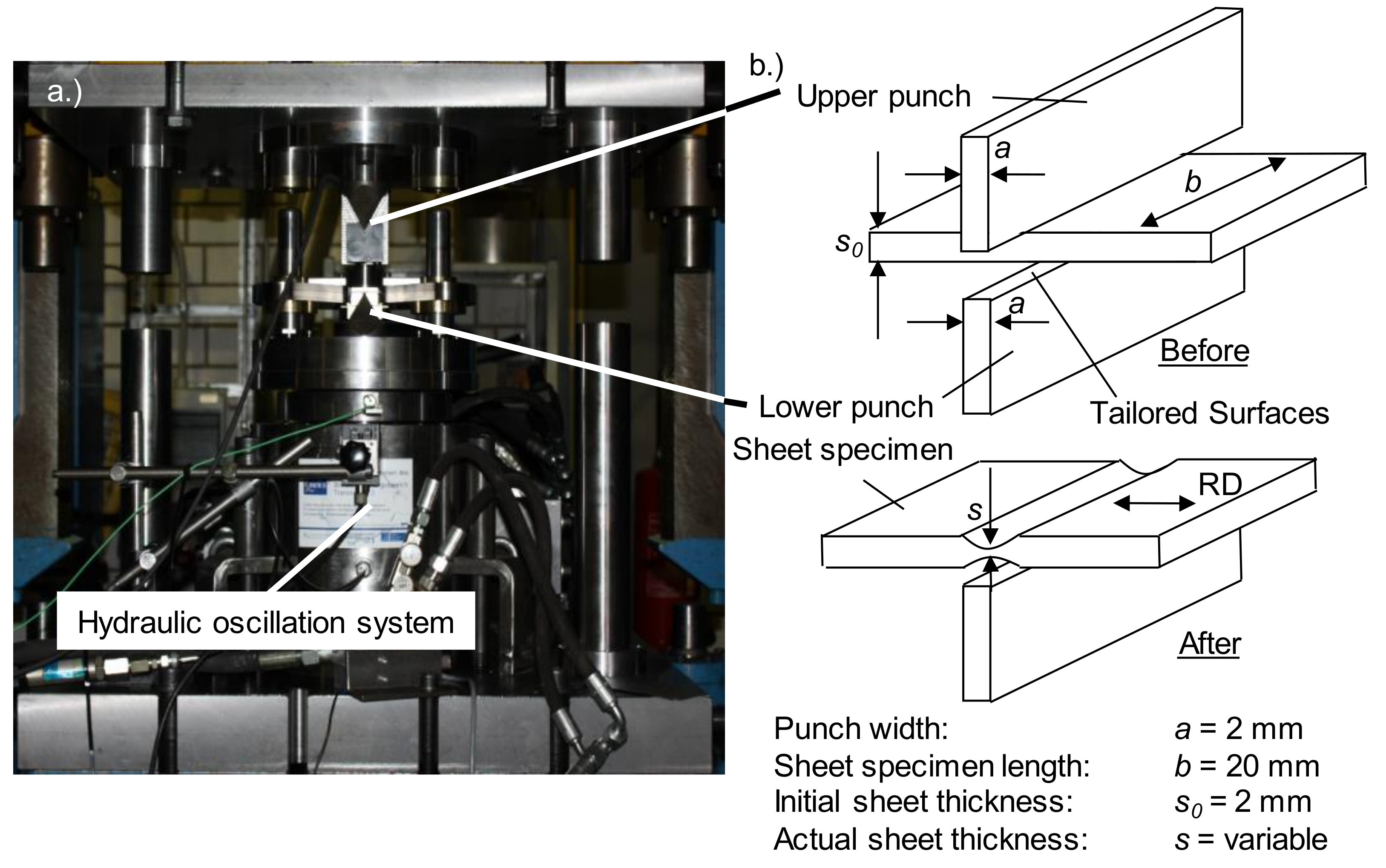
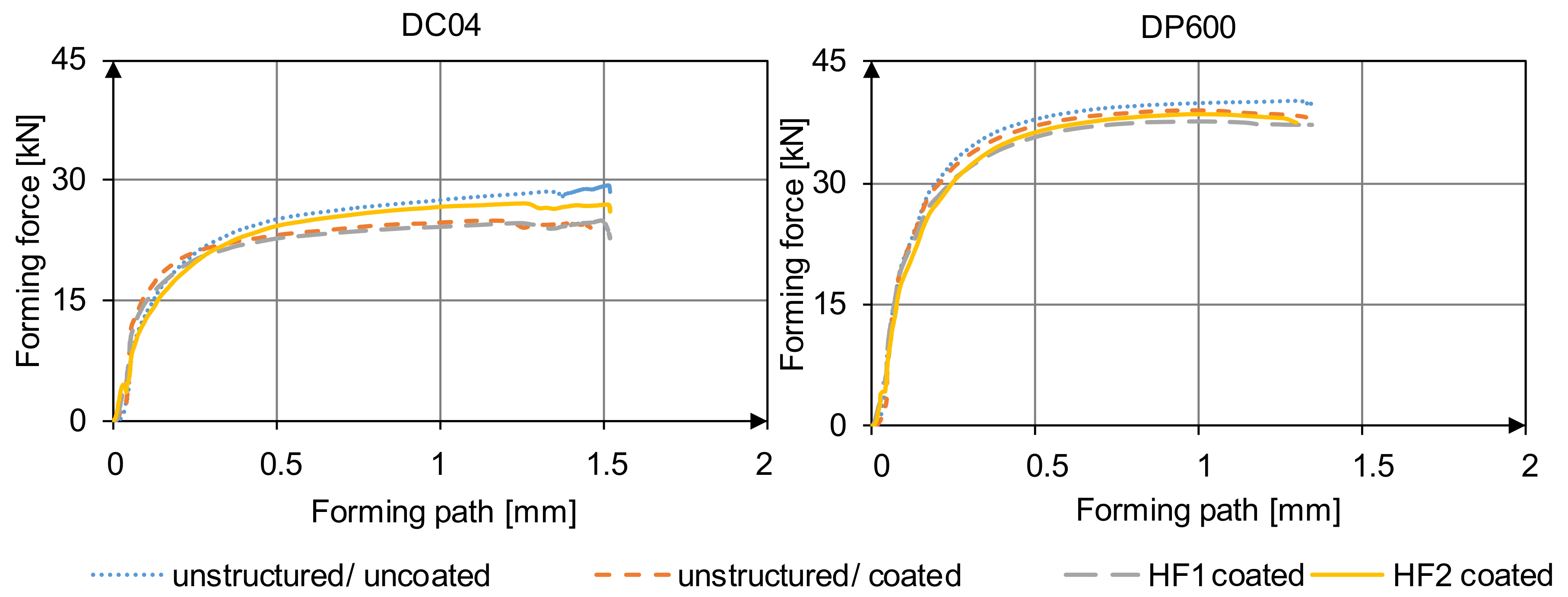


© 2020 by the authors. Licensee MDPI, Basel, Switzerland. This article is an open access article distributed under the terms and conditions of the Creative Commons Attribution (CC BY) license (http://creativecommons.org/licenses/by/4.0/).
Share and Cite
Behrens, B.-A.; Tillmann, W.; Biermann, D.; Hübner, S.; Stangier, D.; Freiburg, D.; Meijer, A.; Koch, S.; Rosenbusch, D.; Müller, P. Influence of Tailored Surfaces and Superimposed-Oscillation on Sheet-Bulk Metal Forming Operations. J. Manuf. Mater. Process. 2020, 4, 41. https://doi.org/10.3390/jmmp4020041
Behrens B-A, Tillmann W, Biermann D, Hübner S, Stangier D, Freiburg D, Meijer A, Koch S, Rosenbusch D, Müller P. Influence of Tailored Surfaces and Superimposed-Oscillation on Sheet-Bulk Metal Forming Operations. Journal of Manufacturing and Materials Processing. 2020; 4(2):41. https://doi.org/10.3390/jmmp4020041
Chicago/Turabian StyleBehrens, Bernd-Arno, Wolfgang Tillmann, Dirk Biermann, Sven Hübner, Dominic Stangier, Dennis Freiburg, Alexander Meijer, Sergej Koch, Daniel Rosenbusch, and Philipp Müller. 2020. "Influence of Tailored Surfaces and Superimposed-Oscillation on Sheet-Bulk Metal Forming Operations" Journal of Manufacturing and Materials Processing 4, no. 2: 41. https://doi.org/10.3390/jmmp4020041
APA StyleBehrens, B.-A., Tillmann, W., Biermann, D., Hübner, S., Stangier, D., Freiburg, D., Meijer, A., Koch, S., Rosenbusch, D., & Müller, P. (2020). Influence of Tailored Surfaces and Superimposed-Oscillation on Sheet-Bulk Metal Forming Operations. Journal of Manufacturing and Materials Processing, 4(2), 41. https://doi.org/10.3390/jmmp4020041





